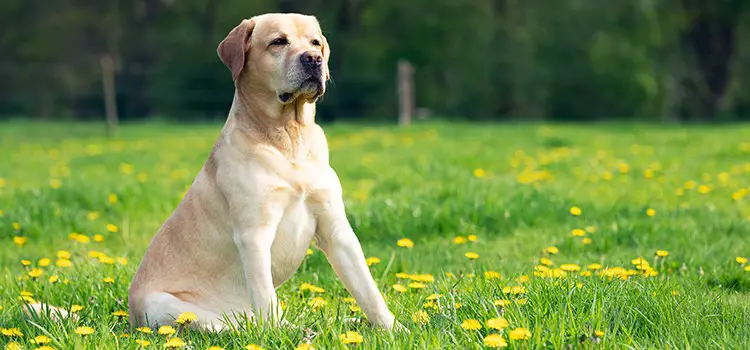One step you can take to maintain your dog’s health and wellbeing is to keep up with their oral hygiene. Buy a toothbrush and toothpaste that are both safe for pets and use them every day. If you have to, you can use a regular toothbrush, such as one that you would use on yourself, but the shape of a dog toothbrush makes it easy for you to maneuver your way around your dog’s teeth. However, when it comes to toothpaste, never use anything other than dog toothpaste.
If you never brush your dog’s teeth, they can develop one of many serious health conditions. Most of these problems are due to plaque that builds up on teeth over time, especially when they are not brushed often enough.
Some dental disorders that can occur are tooth decay, gingivitis, periodontitis, and endodontic disease. As plaque builds up on a dog’s teeth, bacteria accumulates around the gum line and in the crevices of the teeth. As more and more bacteria find their home in the teeth, tooth decay (aka cavities) typically occurs first. After that, it is likely to develop into something that is much more serious.
Eventually, if the poor dental hygiene of a dog is not taken care of by a professional, an infection may form in the mouth. That infection can begin to harm other organs in the body as it spreads. We are talking about a worst-case scenario situation, but it is still crucial to take care of your dog’s teeth because that situation is entirely possible, and happens to dogs all the time, whether their owners are aware of it or not. Most people don’t brush their dog’s teeth every day, but you should do it once a week, at least.
Brushing Dog Teeth: Puppies vs. Adults
The way you brush your dog’s teeth largely depends on their age. A puppy has significantly smaller teeth than a fully-grown adult dog, so it takes a different type of technique and a different style of toothbrush to get the job done.
When a puppy is born or is adopted, their teeth don’t need to be brushed right away. In fact, they might not have teeth yet; in which case, you can begin by gently massaging their gums, if they let you.
Be very careful when massaging a puppy’s gums since they are still small, but it will help a lot with growing in their adult teeth. Typically, you should start brushing puppy teeth around 8 weeks old. Although, it’s not completely necessary to brush their baby teeth since their adult ones will come in at about 15 weeks old.
Once the puppy’s adult teeth have come in, you can start a full schedule of teeth brushing. In the beginning, they may need time to get used to it, but once they are, brush their teeth 3 to 4 times a week.
Adult dogs need their teeth brushed more often than puppies. Try to brush theirs every day or as much as you can in order to prevent plaque buildup and tooth decay.
Of course, for elderly dogs, follow your veterinarian’s given instructions.
Best Toothbrush for Dog
There are three main types of toothbrushes that you can choose from to use on your dog’s teeth. These types are called fingertip, angled, and double-headed. Based on the names, you can vaguely picture what they look like, and you’re probably right.
The type of dog toothbrush you use depends on how behaved your dog is and what your personal preferences are. Not all dogs will stay still enough to have a full-size toothbrush shoved into their mouth, in which case you may want to use a fingertip toothbrush.
Otherwise, use an angled or a double-headed toothbrush, if they let you. Any of these three types will get your mission accomplished and your dog’s smile looking sparkly.
Fingertip Toothbrush for Dog
A fingertip toothbrush for dogs could be an easier way to brush your dog’s teeth, especially if they’re not fond of a regular toothbrush.
How to Use a Fingertip Dog Toothbrush
It is very simple to use a fingertip toothbrush. To use it, slip the brush onto the tip of your index finger. If the brush is too small, you could try placing it on another finger, but it will be easier to use on your index. As you’re putting it on, make sure the bristles are free of dust, hair, or any other unwanted debris.
Wash it off if you must and then resume putting on the toothbrush. At this point, you can add a dab of dog toothpaste if you have it. Never use a human brand of toothpaste on your dog because most of them have ingredients that are not safe for dogs to ingest.
Brush your dog’s teeth the same way you would with any other type of toothbrush. Move it in circles all along the front, top, and back of each tooth. Overbrushing isn’t a huge concern when it comes to fingertip toothbrushes because of the soft bristles they have.
Best Fingertip Toothbrushes
You can find a fingertip toothbrush for your dog at any store that sells dog hygiene items, including all pet stores. The easiest place to buy them is online. The toothbrushes shown below are both for sale online.
The second listing, the ProDental Fingertip Brushes, come in a container of 50 brushes. Usually, you don’t need this many because they last quite a while; however, dogs who like to chew through everything will most likely need plenty of backups. It’s better to be safe than sorry.
Pet Republique Dog Fingertip Toothbrush for Dogs
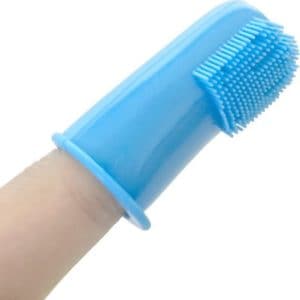
ProDental Fingertip Brushes for Dogs
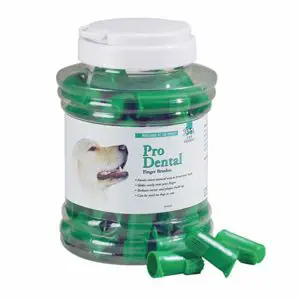
Angled Dog Toothbrush
An angled toothbrush for dogs looks similar to a regularly shaped toothbrush, but the tip that has the bristles on it is angled slightly to a direction that opposes the vertical length of the toothbrush. These toothbrushes are great for hard to reach areas of a dog’s mouth, like in the back by their molars.
A dog’s mouth opens wider than a human’s; but if the dog doesn’t like to have his teeth brushed, you need an easier way to scrub the back teeth without poking the inside of their cheek. This way, if you are brushing their teeth by entering through the side of their mouth, you can use the angled toothbrush rather than twisting your hand at an awkward angle with a regular brush.
How to Use an Angled Toothbrush for Dogs
Angled toothbrushes are designed to make brushing a dog’s teeth more convenient. Use the angled toothbrush the same way you would use any other toothbrush; add toothpaste, brush in small circles, and rinse. To make sure you reach every tooth, start on one side of the mouth, and work your way to the other side.
All the while, brush in small circles on the front, back, top, and along the gumline. The gums are the most critical area to brush since that is where decay is most likely to happen in a dog’s mouth. Gingivitis, which occurs along the gum line, can be easily avoided with the proper dental care regimen.
Best Angled Toothbrushes for Dog
An angled toothbrush is the go-to type of toothbrush for dogs. Find a decent-quality and durable angled toothbrush that you can use for a long time. Dog toothbrushes don’t need to be replaced often unless they are chewed or become dirty.
There are plenty of options online for these dog toothbrushes, and many of them are vet-approved or at least recommended by vets. Below, you will see that there are a few of the best-angled toothbrushes for dogs listed, including an option for puppies. Click the link below the image shown to view further information and pricing for that product.
Vetoquinol Vet Solutions Enzadent Poultry-Flavored Toothbrush Kit – for Dogs and Cats
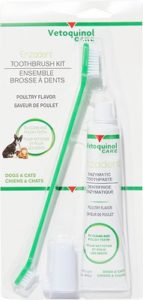
Nylabone Advanced Oral Care Dental Kit – Puppy
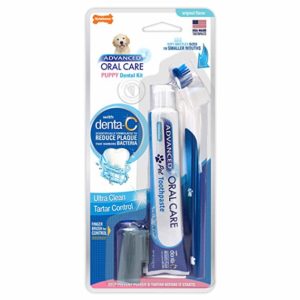
Arm & Hammer Dental Clinical Gum Health Dog Toothbrush Kit
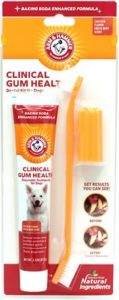
Double Headed Dog Toothbrush
Double-headed dog toothbrushes look odd, but they will help you brush your dog’s teeth a lot faster. On the tip of the toothbrush, rather than having a single head of bristles, it has two heads, each with their own set of bristles. The two heads face each other, creating an area of 360-degree cleaning. It saves you time when you are brushing your dog’s teeth; instead of having to brush on each side of a tooth, you can brush all sides at once.
How to Use a Double-Headed Toothbrush for Dogs
Using a double-headed toothbrush to clean a dog’s teeth is different than using a fingertip or an angled dog toothbrush.
When you are squeezing toothpaste onto the brush, make sure that the majority of the glob is in-between the two bristle heads. Otherwise, the toothpaste won’t get to the crevices between the dog’s teeth. It is important to reach every area in your dog’s mouth and to get it as clean as they will let you. Doggy dental visits are anything but cheap.
To use the double-headed dog toothbrush, put dog toothpaste on the bristles. Use a vet-approved toothpaste that is safe for dogs. You only need to add a small amount of paste to the brush. Scrub the toothbrush back and forth in an oval motion to get all of their teeth clean, from top to bottom. If you are using it correctly, you should be able to clean several teeth at once since the toothbrush runs along the row.
Best Double-Headed Toothbrush for Dog
There are a few top pet brands that offer double-headed toothbrushes. The first product shown below is made by TropiClean. This brush is the best double-headed toothbrush for dogs, and it is veterinarian-approved. The other toothbrush is a good option as well and is veterinarian recommended.
TropiClean Fresh Breath Tripleflex Dog Toothbrush

Petosan Double-Headed Dog Toothbrush
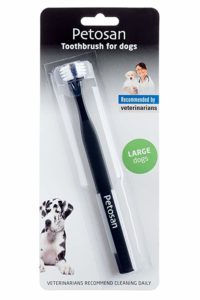
Why Should You Buy a Vet-Approved Dog Toothbrush?
Veterinarians work hard in life to provide the best care they can to dogs and other pets they treat on a day-to-day basis. For most vets, their job is personal to them, and they become emotionally attached to healing their patients. They also went through extensive schooling and interning before they were even able to become a veterinarian, so they have lots of experience and knowledge of pet health.
Brushing your dog’s teeth isn’t just, so they look pretty, it is so they are healthy. Lack of oral hygiene is a serious problem in dogs, and it can lead to much more serious health conditions, as well as infections and bad breath.
When a dog toothbrush says it is vet-approved, you should know that this means it is a good product. Always buy the best for your dog when it comes to hygiene products; they will thank you for it. Good health leads to a longer life.
Continue Brushing!
Once you find the best toothbrush and toothpaste for your dog, continue to brush their teeth as often as possible. If you are ever unsure about your brushing technique or the brand you are using, it doesn’t hurt to call your vet to get their professional opinion. You can always look up information online but talking to a real veterinarian is more reliable.
You may also want to consider taking your dog for dental checkups every so often. Checkups and cleanings will help prevent unwanted plaque buildup and give you plenty of warning before gingivitis or another oral health problem sets in. If your dog is a puppy, checkups are even more important. The vet can monitor your puppy’s overall health and keep track of how their baby teeth are doing as they begin to show.
Sometimes, a puppy’s teeth grow in at a weird angle or are squished together. Many dogs also experience problems with overbites and underbites. Your vet can help inform you about available procedures and do everything in their power to make sure your pup isn’t in pain.
